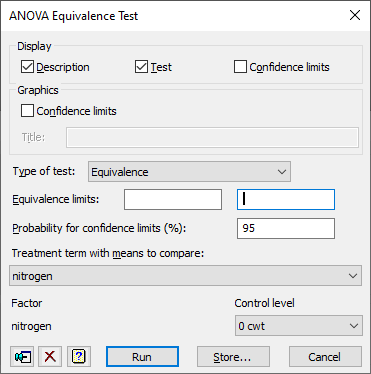This dialog performs equivalence, non-inferiority and non-superiority tests for a selected treatment term from a balanced analysis of variance. This compares a control mean in a treatment term with all the other groups in the term. The equivalence limits give how different the means can be from the control and still be regarded as equivalent, non-inferior or non-superior.
- To perform equivalence testing following an analysis of variance, click Further output then click Equivalence tests.
You can save the results by clicking Store.

Display
Select items to be displayed in the Output window.
| Description | A description of the test. |
| Test | The t statistics and probabilities for differences from control. |
| Confidence limits | The confidence limits for the differences from control. |
Graphics
Select the Confidence limits item to plot these. The Title field can be used to provide a title for the plot. If left empty, an automatic title will be provided. Enter a blank for the title field to suppress a title.
Type of test
Enables you to choose the type of t-test to perform.
| Equivalence | The null hypothesis is that the difference between the control and the other group lies outside two limits specified in the Equivalence limits fields. |
| Non-inferiority | The null hypothesis is that the mean of the control minus the mean of the other group is less than the negative value specified, in the Equivalence limit field. |
| Non-superiority | The null hypothesis is that the mean of the control minus the mean of the other group is greater than the positive value specified, in the Equivalence limit field. |
Probability for confidence limit (%)
Enables you to control the coverage probability for the confidence intervals. The probability is expressed as a percentage and must be between 0 and 100.
Equivalence limit(s)
For the Equivalence, Non-inferiority and Non-superiority tests, this gives the limits for the difference between the means.
| Equivalence | Specify the lower and upper boundaries for the zone for the difference between the two means, within which they are judged to be equivalent. The lower limit in the left-hand box must be negative, and the upper limit within the right-hand box positive. |
| Non-inferiority | Specify a lower limit for equivalence. The second mean is judged to be not-inferior to the first when its difference from the first mean is above this limit. The limit must be negative. |
| Non-superiority | Specify an upper limit for equivalence. The second mean is judged to be not-superior to the first when the difference from the first mean is below this limit. The limit must be positive. |
Treatment term with means to compare
This drop-down list gives the treatment terms fitted in the analysis of variance. Select one of these to perform the test on. Once you selected a term, you will need to specify the control group by selecting the Control level for each Factor in the term. The default control levels are the first level in each factor.
Store
This button allows you to specify the results from the test to be saved using the ANOVA Equivalence Test Store Options dialog.
Action Icons
| Pin | Controls whether to keep the dialog open when you click Run. When the pin is up |
|
| Clear | Clear all fields and list boxes. | |
| Help | Open the Help topic for this dialog. |
See also
- Store Options to store the results
- TEQUIVALENCE procedure
- TTEST procedure